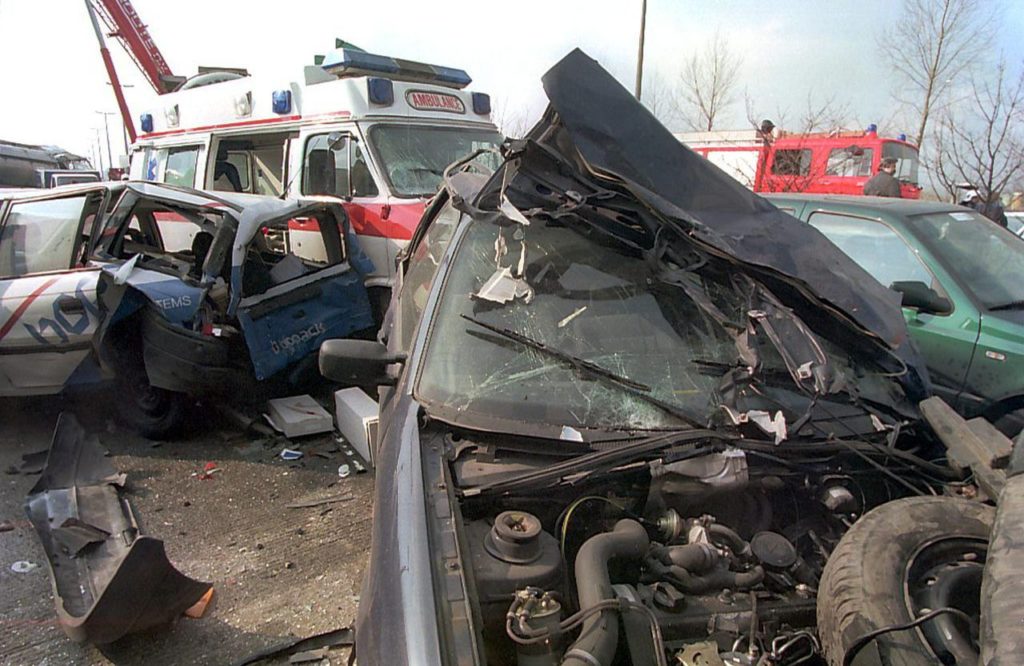Exactly 25 years ago today, on Tuesday 27 February 1996 at 10.00, a serious road accident took place that would come to be the worst ever on Belgium’s roads.
The accident took place on the E17 motorway near the town of Nazareth in East Flanders, just south of Ghent. Suddenly, traffic ran into a bank of mist that cut off all vision.
More than 200 vehicles were involved in the pile-up, and fire broke out. Ten people lost their lives, and 56 more were seriously injured.
Koen Van Hecke was at the time a volunteer with the fire service.
“I was working on my car, and the radio was going on about a lot of fog in West and East Flanders,” he told Canvas in 2013.
“Visibility was limited to 50m or even 20m. The 10 o'clock weather report was just underway when the fire alarm went off to indicate a suspected pile-up on the E17. As I drove my car to the station, I saw at the highest point at Gavere a plume of smoke rising above the road. I was already thinking then: please let it not be true.”
On arrival, the crew could not determine where the pile-up started and ended. The emergency number (then 100) reckoned it had started at about the Deinze exit. Although some people had mobile phones by that time, the network had been crushed by the weight of traffic, of people trying to make calls from the wreckage.
“I had already warned the guys: get ready for serious extractions [of passengers from smashed vehicles] and resuscitations. People involved in the accident or in a traffic jam told us that a serious fire was going on, but we couldn't see it,” Van Hecke said.
“We did feel that it was warm and we could hear crackling. The officer then appointed a team to fight the fire, and he ordered me to take a team to search for victims.”
The first victim they found was a truck driver trapped in his cabin, but he was already dead. Then a man and his injured wife in a van crushed between two lorries.
“We couldn’t reach them from where we were standing. Then we went all the way back and crawled under one of the trucks to reach them, but the woman too had died.
“So we had to choose: what do we do now? The man had pain in his pelvis but he seemed stable. The driver in the vehicle in front was far worse off,” he said.
“I told the man in the van: you are going to have to be patient because we have to help the person in front of you first. The man said, go ahead, that man must be hurt worse. I had a hard time with that as he was with his deceased wife and we had to abandon him for a while.”
At the end of the day 10 people were dead and 55 seriously injured.
After the accident, the police in East Flanders instituted Road Safety Day, which has taken place on or around 27 February in the years since.
This year’s edition took place yesterday. At more than 130 locations, police from 27 local zones and officers from the federal police carried out checks on 4,456 vehicles. Of those, 9.1% were driving too fast, the highest percentage since 2016. Five drivers immediately were relieved of their licences.
“We know what causes road deaths, and we have to take strict action,” said Erwin Dernicourt, prosecutor-general at the court of appeal in Ghent, who was present at a roadside check in Erpe Mere.
“Not only do we check for speeding or alcohol abuse, we also keep a close eye on whether you use your mobile phone at the wheel and whether you have your seat belt on. There are still too many drivers who forget the seat belt, even though it really can save your life.”
Alan Hope
The Brussels Times

